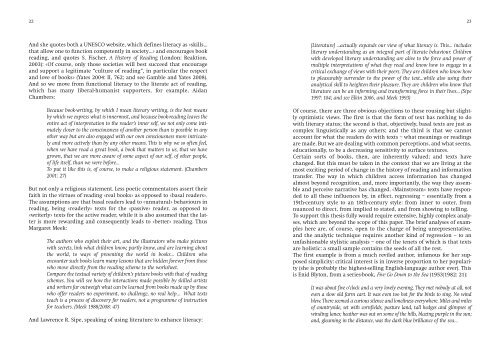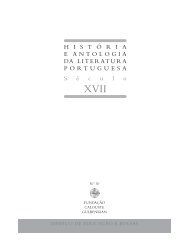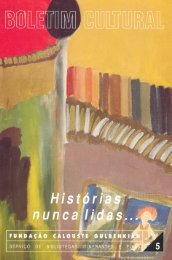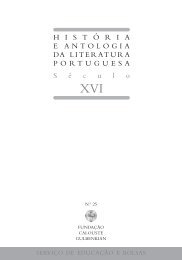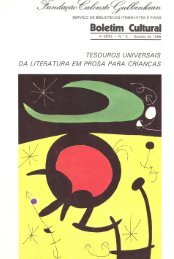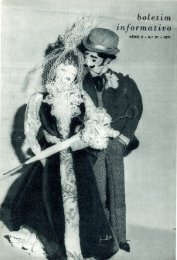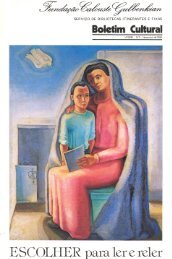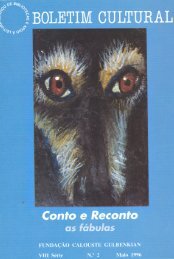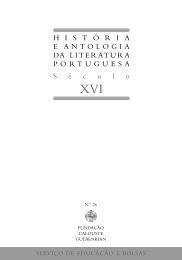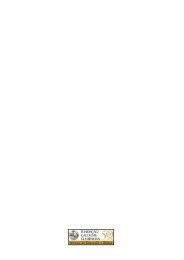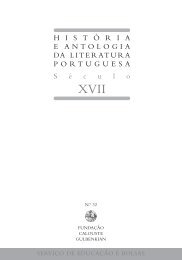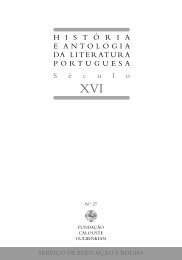Formar Leitores para Ler o Mundo - Leitura Gulbenkian - Fundação ...
Formar Leitores para Ler o Mundo - Leitura Gulbenkian - Fundação ...
Formar Leitores para Ler o Mundo - Leitura Gulbenkian - Fundação ...
You also want an ePaper? Increase the reach of your titles
YUMPU automatically turns print PDFs into web optimized ePapers that Google loves.
22<br />
And she quotes both a UNESCO website, which defines literacy as «skills…<br />
that allow one to function competently in society…» and encourages book<br />
reading, and quotes S. Fischer, A History of Reading (London: Reaktion,<br />
2003): «Of course, only those societies will best succeed that encourage<br />
and support a legitimate “culture of reading”, in particular the respect<br />
and love of books» (Yates 2004: II, 762; and see Gamble and Yates 2008).<br />
And so we move from functional literacy to the literate act of reading,<br />
which has many liberal-humanist supporters, for example, Aidan<br />
Chambers:<br />
Because book-writing, by which I mean literary writing, is the best means<br />
by which we express what is innermost, and because book-reading leaves the<br />
entire act of interpretation to the reader’s inner self, we not only come intimately<br />
closer to the consciousness of another person than is possible in any<br />
other way but are also engaged with our own consciousness more intricately<br />
and more actively than by any other means. This is why we so often feel,<br />
when we have read a great book, a book that matters to us, that we have<br />
grown, that we are more aware of some aspect of our self, of other people,<br />
of life itself, than we were before…<br />
To put it like this is, of course, to make a religious statement. (Chambers<br />
2001: 27)<br />
But not only a religious statement. Less poetic commentators assert their<br />
faith in the virtues of reading «real books» as opposed to «basal readers».<br />
The assumptions are that basal readers lead to «unnatural» behaviours in<br />
reading, being «readerly» texts for the «passive» reader, as opposed to<br />
«writerly» texts for the active reader, while it is also assumed that the latter<br />
is more rewarding and consequently leads to «better» reading. Thus<br />
Margaret Meek:<br />
The authors who exploit their art, and the illustrators who make pictures<br />
with secrets, link what children know, partly know, and are learning about<br />
the world, to ways of presenting the world in books… Children who<br />
encounter such books learn many lessons that are hidden forever from those<br />
who move directly from the reading scheme to the worksheet.<br />
Compare the textual variety of children’s picture books with that of reading<br />
schemes. You will see how the interactions made possible by skilled artists<br />
and writers far outweigh what can be learned from books made up by those<br />
who offer readers no experiment, no challenge, no real help… What texts<br />
teach is a process of discovery for readers, not a programme of instruction<br />
for teachers. (Meek 1988/2008: 47)<br />
And Lawrence R. Sipe, speaking of using literature to enhance literacy:<br />
[Literature] ...actually expands our view of what literacy is. This... includes<br />
literary understanding as an integral part of literate behaviour. Children<br />
with developed literary understanding are alive to the force and power of<br />
multiple interpretations of what they read and know how to engage in a<br />
critical exchange of views with their peers. They are children who know how<br />
to pleasurably surrender to the power of the text...while also using their<br />
analytical skill to heighten their pleasure. They are children who know that<br />
literature can be an informing and transforming force in their lives... (Sipe<br />
1997: 104; and see Elkin 2006, and Meek 1993)<br />
Of course, there are three obvious objections to these rousing but slightly<br />
optimistic views. The first is that the form of text has nothing to do<br />
with literary status; the second is that, objectively, basal texts are just as<br />
complex linguistically as any others; and the third is that we cannot<br />
account for what the readers do with texts – what meanings or readings<br />
are made. But we are dealing with common perceptions, and what seems,<br />
educationally, to be a decreasing sensitivity to surface textures.<br />
Certain sorts of books, then, are inherently valued; and texts have<br />
changed. But this must be taken in the context that we are living at the<br />
most exciting period of change in the history of reading and information<br />
transfer. The way in which children access information has changed<br />
almost beyond recognition, and, more importantly, the way they assemble<br />
and perceive narrative has changed. «Mainstream» texts have responded<br />
to all these influences by, in effect, regressing – essentially from a<br />
19th-century style to an 18th-century style: from inner to outer, from<br />
nuanced to direct, from implied to stated, and from showing to telling.<br />
To support this thesis fully would require extensive, highly complex analyses,<br />
which are beyond the scope of this paper. The brief analyses of examples<br />
here are, of course, open to the charge of being unrepresentative,<br />
and the analytic technique requires another kind of regression – to an<br />
unfashionable stylistic analysis – one of the tenets of which is that texts<br />
are holistic: a small sample contains the seeds of all the rest.<br />
The first example is from a much reviled author, infamous for her supposed<br />
simplicity: critical interest is in inverse proportion to her popularity<br />
(she is probably the highest-selling English-language author ever). This<br />
is Enid Blyton, from a series-book, Five Go Down to the Sea (1953/1982: 21):<br />
It was about five o’clock and a very lovely evening. They met nobody at all, not<br />
even a slow old farm cart. It was even too hot for the birds to sing. No wind<br />
blew. There seemed a curious silence and loneliness everywhere. Miles and miles<br />
of countryside, set with cornfields, pasture land, tall hedges and glimpses of<br />
winding lanes; heather was out on some of the hills, blazing purple in the sun;<br />
and, gleaming in the distance, was the dark blue brilliance of the sea...<br />
23


